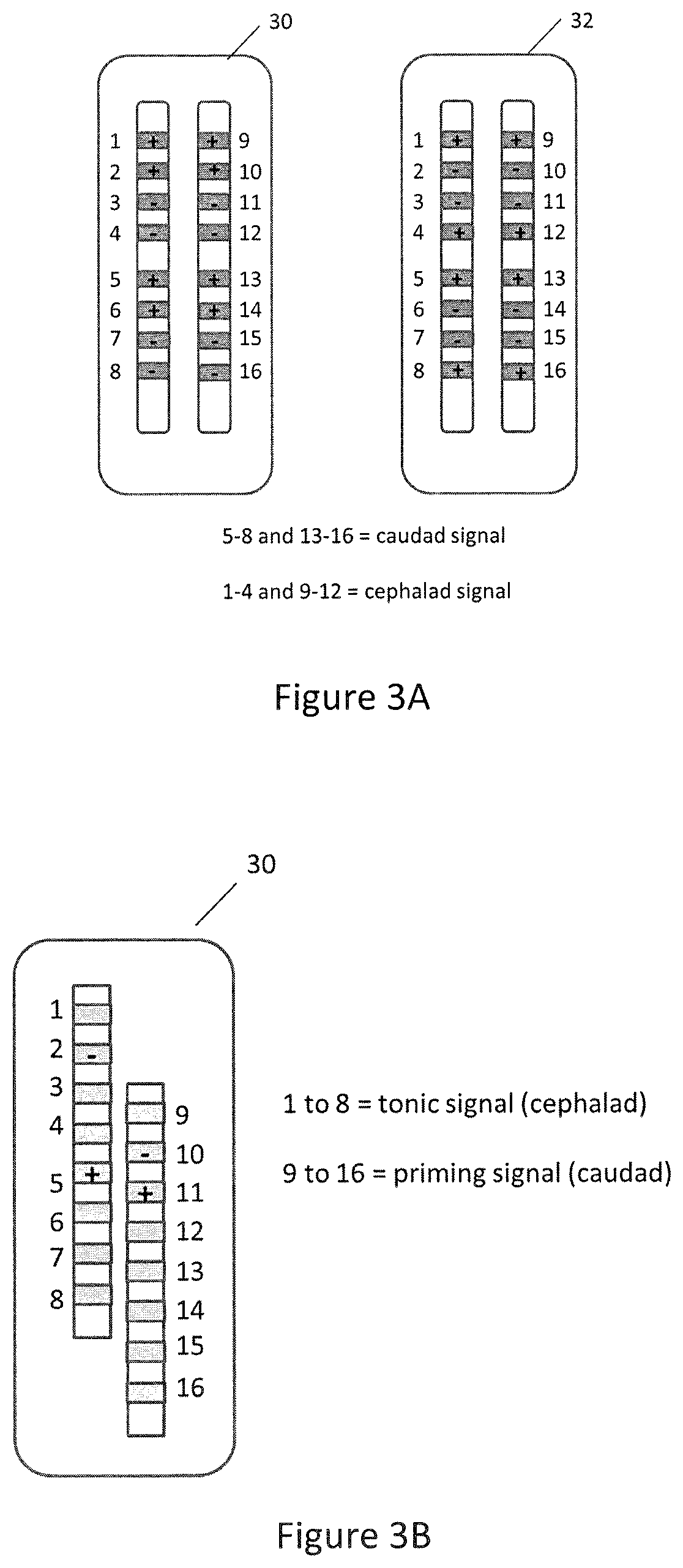Method and apparatus for multimodal electrical modulation of pain using composite electromagnetic fields
a multi-modal electrical modulation and electromagnetic field technology, applied in the field of multi-modal electrical modulation of pain using composite electromagnetic fields, can solve the problem that the mechanism by which scs provides an analgesic effect is not fully understood, and achieve the effect of improving pain relief and relieving chronic pain
- Summary
- Abstract
- Description
- Claims
- Application Information
AI Technical Summary
Benefits of technology
Problems solved by technology
Method used
Image
Examples
example 1
[0120]Referring to FIG. 15, an initial pilot study using an animal model for neuropathic chronic pain was carried out (n=29). In this study, a peripheral nerve injury was surgically induced by transecting the tibial and peroneal branches of the sciatic nerve at the point of trifurcation while sparing the sural nerve (spared nerve injury, SNI, model). After four days of transection, the subject develops mechanical and thermal hypersensitivity (allodynia), which is considered pain-like behavior. Subjects were implanted with a small cylindrical four-contact lead fitted surgically into their epidural space at the vertebral level corresponding to the innervation of the sciatic nerve. At day four post-surgery subjects were behaviorally tested using von Frey filaments. These filaments of different tensile strength are used to measure the sensitivity of a skin area affected by the nerve injury to mechanical stimulation. In the SNI model, the plantar area of the hind paw ipsilateral to injur...
example 2
[0123]In the example, the genome-wide expression effects in ipsilateral dorsal spinal cord (DC) tissues of spinal cord stimulation (administered for 72 h) were assessed in rats induced with chronic neuropathic pain after peripheral nerve injury. Specifically, in the example genome-wide expression levels were compared between animals of one the most commonly used rodent models for chronic neuropathic pain (spare nerve injury, SNI) upon continuous SCS and sham-treated animals, i.e., animals in which the pain model was induced, and were implanted, but not stimulated.
[0124]The genome-wide expression profiling microarray commercially available for the laboratory rat employed in the current studies was capable of surveying the expression of about 21,000 genes. Enrichment analysis based on clustering statistics (using weighted gene correlation network analysis (WGCNA)) allowed for the identification of modules (or subsets) that contained genes that were highly correlated to each other in t...
example 3
[0140]The effect of phase polarity upon the modulation of genes previously presented was carried out using an animal model of chronic neuropathic pain. In this example, tissues from the spinal cord were obtained from animals, which were stimulated using a rectangular waveform at a frequency of 50 Hz and a pulse width of 200 μs per phase which were either monophasic cathodic, monophasic anodic, or symmetric biphasic with an initial cathodic polarity. RNA from tissues was extracted and cDNA was prepared by reverse transcription. RNA expression levels were assessed using real-time PCR, with levels quantified and standardized. Based on the above experiments (example 2), a panel of genes including markers for glial activation (tlr2, cxcl16), calcium-dependent glial processes (Cabp1), immune system activation (cd68), and an opioid receptor (oprm1) was selected for analysis.
[0141]FIGS. 17A-17E illustrate conceptually graphs of observed expression levels of selected genes relative to the po...
PUM
 Login to View More
Login to View More Abstract
Description
Claims
Application Information
 Login to View More
Login to View More - R&D
- Intellectual Property
- Life Sciences
- Materials
- Tech Scout
- Unparalleled Data Quality
- Higher Quality Content
- 60% Fewer Hallucinations
Browse by: Latest US Patents, China's latest patents, Technical Efficacy Thesaurus, Application Domain, Technology Topic, Popular Technical Reports.
© 2025 PatSnap. All rights reserved.Legal|Privacy policy|Modern Slavery Act Transparency Statement|Sitemap|About US| Contact US: help@patsnap.com



